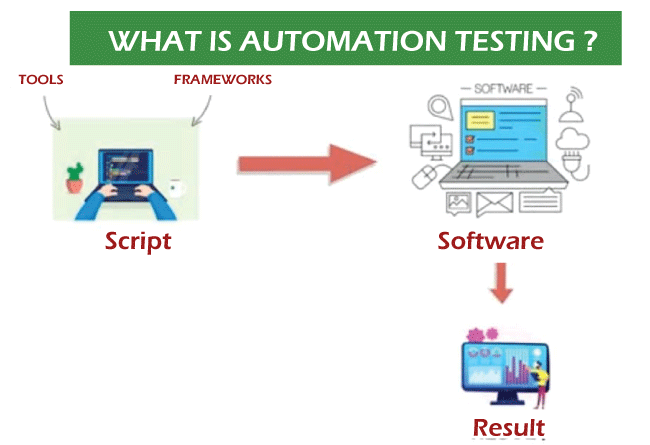Automation Testing Structures: Streamlining Complicated Testing Situations
Automation Testing Structures: Streamlining Complicated Testing Situations
Blog Article
From Guidebook to Automated Screening: A Comprehensive Overview to Transitioning Efficiently and Successfully
In the world of software program screening, the change from handbook to automated procedures has become a progressively important transition for organizations looking for to boost performance and precision in their testing methods. As technology remains to advance, the demand for smooth and reliable automated testing methods has never ever been extra important. The journey from manual to automated testing is not without its obstacles, yet when approached tactically and with a clear plan in mind, the advantages can be considerable - automation testing. In this comprehensive overview, we will explore essential steps and considerations essential for a successful transition, from the initial selection of devices to the combination of automation into existing operations. Stay tuned to reveal the understandings that will certainly assist lead the way for a smoother and a lot more effective screening process.
Benefits of Automated Checking
Automated testing uses numerous advantages, boosting efficiency and accuracy in software program development procedures. One key benefit is the considerable decrease in testing time. Automated tests can be run at the same time on several gadgets and running systems, substantially speeding up the testing stage contrasted to manual testing. This enhanced performance permits faster feedback on the quality of the software application, making it possible for developers to identify and deal with problems promptly.
Additionally, automated testing makes certain a greater level of precision in finding flaws. Consistency in screening is likewise improved, as automated examinations perform the same actions exactly each time they are run.
Selecting the Right Devices

To start with, analyze your needs and purposes. Comprehend the range of your project, the technologies entailed, and the ability of your group. This evaluation will help you identify the features and capabilities you need in your screening devices.
Second of all, think about the compatibility of the tools with your existing systems and procedures. Seamless integration with your existing software program growth lifecycle is important to make sure a smooth change to automation.
In addition, assess the scalability and flexibility of the devices. As your testing needs advance, the tools should have the ability to adapt and suit adjustments properly.
Finally, consider the assistance and neighborhood around the devices. Robust assistance and an active user neighborhood can offer beneficial sources and help when implementing automated screening. By meticulously thinking about these facets, you can choose the right devices that align with your demands and established the stage for an effective transition to automated testing.
Writing Efficient Examination Manuscripts

When crafting test manuscripts, it is necessary to think about the specific demands of the software being checked see it here and ensure that the manuscripts address all important functionalities. Clear and detailed naming conventions for examination scripts and examination cases can improve readability and maintainability. In addition, incorporating error handling devices within the test scripts can aid in identifying and attending to concerns quickly.
Moreover, arranging test scripts right into modular parts can improve reusability and scalability, minimizing redundancy and boosting efficiency in test helpful resources script upkeep. Normal reviews and updates to evaluate manuscripts are critical to maintain speed with advancing software needs and capabilities. By complying with these concepts, testers can develop reliable and durable examination manuscripts that contribute considerably to the success of automated testing processes.
Integrating Automation Into Workflows
By flawlessly integrating automated screening tools like Selenium or Appium right into the software application growth lifecycle, teams can attain faster feedback on code adjustments, leading to quicker bug discovery and resolution. This integration enables for continuous testing throughout the growth process, making certain that any problems are identified early on, resulting in higher software program quality. Correct integration of automation tools calls for collaboration between growth, testing, and operations groups to develop a unified workflow that enhances effectiveness and effectiveness in delivering high-grade software items.
Making Sure a Smooth Change
Successfully transitioning to automated testing includes thorough planning and careful execution to lessen disruptions and optimize effectiveness in the software program growth procedure - automation testing. To ensure a smooth transition, it is vital to begin by performing a thorough assessment of the current testing processes and identifying areas where automation can bring the most significant benefits. Engaging with all stakeholders early on while doing so, including developers, testers, and task supervisors, is critical for amassing support and buy-in for the automation effort
Communication is essential during this transition stage. Clear interaction of the objectives, benefits, and expectations of automated testing aids to handle any type of resistance or issues that may develop. Furthermore, offering sufficient training and resources for staff member to upskill in automation tools and techniques is vital for making certain an effective shift.

Final Thought
Finally, transitioning from guidebook to automated screening supplies countless advantages, consisting of increased efficiency and reliability. By selecting the appropriate tools, writing effective examination manuscripts, and incorporating automation effortlessly into process, companies can guarantee a smooth and successful transition. It is vital to embrace automation as an important asset in software screening procedures to enhance overall quality and productivity.
In the world of software program screening, the shift from manual to automated procedures has actually ended up being an increasingly dig this vital change for companies seeking to enhance performance and precision in their screening techniques. Automated tests can be run concurrently on multiple tools and running systems, considerably speeding up the testing stage contrasted to manual screening. Consistency in testing is additionally enhanced, as automated tests carry out the exact same steps precisely each time they are run.To guarantee the successful implementation of selected testing tools, the production of reliable examination manuscripts plays a crucial role in validating the capability and performance of automated procedures - automation testing. By adhering to these principles, testers can produce reliable and durable examination scripts that contribute considerably to the success of automated screening processes
Report this page